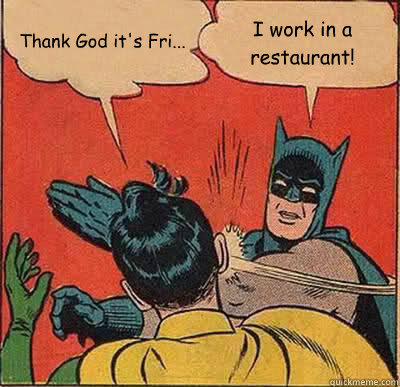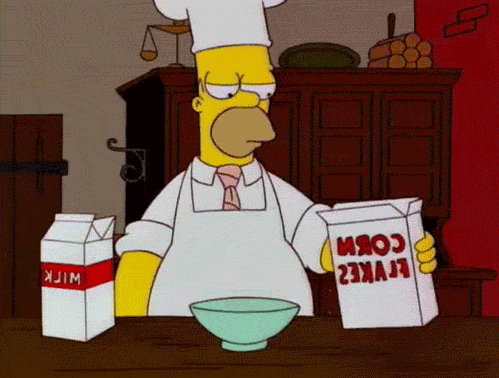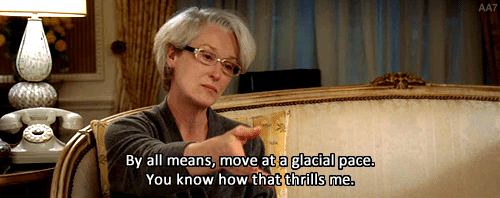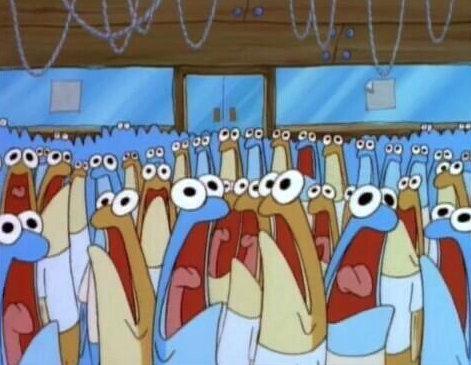
GIF courtesy of Giphy.com
I’ve worked in several different food service establishments thus far in my 20 years of life. Each is unique, but there are some common words and phrases that are constant throughout them all. Here is a guide to kitchen jargon, based on what I’ve come across.
1. “Mise en place”

GIF courtesy of tumblr.com
It translates to “put in place” from French. This is one of the first things I was taught when I started working in kitchens. It simply means to have everything prepped and ready before you do something. Make sure you have all of your ingredients out and measured before starting to cook, that way you don’t forget anything. While you can take it literally, you can also adopt this as a philosophy for the rest of your life, too. I sure have.
#SpoonTip: The correct pronunciation is “meez-en-plas.”
2. “FOH” or “BOH”

Photo courtesy of quickmeme.com
This stands for Front of House/Back of House. The front consists of restaurant managers, hosts, waiters, and such. The back of house is the cooking staff and dishwashers. From what I’ve experienced, the FOH and BOH become pretty close. This is necessary to keep the restaurant flowing smoothly.
3. “All day”

GIF courtesy of tumblr.com
This tells a cook how much of a certain item they need to be making across all of the current orders. Sometimes it’s hard to remember how many of a dish you need to be making when there are a bunch of other orders that also need to be made. In this situation, you would ask how many of something you need all day. It’s a lifesaver when four orders just came in right on top of each other and you can’t remember if there were two pasta entrees or three.
4. “Walking in”

GIF courtesy of tumblr.com
As in: “We’ve got a salmon and pork entrée walking in.” Obviously, the salmon and pork aren’t walking themselves into the kitchen to be cooked. Sounds like a health code violation to me…
This is something that signals to the kitchen that a new order has just come in. It really came in handy at one restaurant I worked at because our printer didn’t make any noise when a new order came in. Usually, the cook closest to the printer or an Expo (we’ll come back to what this is in a bit) would yell “walking in” to get everyone’s attention before calling out the order.
5. “On the fly”

GIF courtesy of giphy.com
Sometimes orders don’t get put in correctly or even at all, so when a customer needs food right away, cooks are asked for it “on the fly.” That means “right this second, drop everything and get that food out immediately.” So if you were to forget an order or come up short with a dish at a particular table, you’d need it “on the fly” because everyone else already has their food.
6. “In the weeds”

GIF courtesy of tumblr.com
This means that a cook is being slammed with orders and getting really overwhelmed. There were definitely a few times I was in the weeds, especially when I first started off in live-service (a typical restaurant setting where you order food and it is made for you right then). After a couple times of being in the weeds, you learn to keep up.
7. “Behind!”

GIF courtesy of fanpop.com
Even if you’ve never worked in food service you can probably guess that “behind!” means “behind you.” While it’s pretty self-explanatory, it’s also one of the most important things to know. Kitchens get pretty hectic and no one wants any collisions, so “behind!” is sort of a safety precaution. You can be more specific by adding “hot, behind” or “sharp, behind” to let others know to be extra careful when you have something hot or sharp behind them.
Strangely, this was one of the most difficult things for me to pick up when I started working in kitchens. I’m a pretty quiet person, so having to yell and be disruptive was weird for me. But like many things, the kitchen has changed this about me. It’s better to be safe than sorry so if loudly announcing my presence is what it takes then hear me roar.
8. “(Insert #)-top”

Photo courtesy of imgur.com
This one just means the number of people at a particular table. So, a 20-top would be a party of 20 people. There can be a 6-top, a 2-top, or any number-top. If servers have time, they can warn the kitchen of a new 8-top (or however many-top) that just walked in so they can be prepared.
9. “Runner”

GIF courtesy of tumblr.com
A Runner, although encouraged to move fast, should not actually run. However, they should be walking very fervently to pick up food from the kitchen and get it to the appropriate table. They are usually servers, but can sometimes even be managers. Really, it’s anyone available to bring the customers their food. Have you ever been eating out and had your food brought to you by someone who is most definitely not the person who took your order? Well, that was a runner.
No one wants food sitting in the window, which is not an actual window. It’s where food is put after it is made and before it goes out to customers, while being heated to keep warm. So when a runner is called for, anyone who is available should step up to bring out the food.
10. “Expo”

GIF courtesy of tumblr.com
Short for Expeditor, an expo is true to their name. They’re job is to expedite, or accelerate, orders and make sure the kitchen runs smoothly. In my experience, this person is always a cook or chef, but a manager has stepped in a time or two when we’ve been short-staffed and need all the cooks on the line.
They call out the orders when they come in and keep track of everything so food is made and delivered in a timely manner. This is the person that tells you what you need to make, so they are pretty much the most important person to you during service. They’re also person you can ask “How much do I have all day?”
They finish plates before they go out because dishes will usually have multiple components from various parts of the line. The Expo will add any sides or garnishes and make sure the plates look good before sending them out with a runner.
Expo is one of my favorite jobs in the kitchen, even though it can be one of the toughest. You have to be organized in order to keep everyone on track and keep track of all of the current orders. You often find yourself saying “How long do we have on that sandwich to finish this order?” The best part, to me at least, is finishing plates because you get to make sure the food is plated right and looks pretty before being sent to customers. The downside is that you don’t get to make food, which is reserved for the cooks on the line.
No one has time to form complete sentences when they’re being slammed with orders. These phrases help speed things up, making life a whole lot easier for everyone on the restaurant staff. Listen for some of these the next time you get seated close to the kitchen at a restaurant and you’re sure to sound like a pro in no time.


